coolant reservoir KIA CARENS RHD 2018 Owners Manual
[x] Cancel search | Manufacturer: KIA, Model Year: 2018, Model line: CARENS RHD, Model: KIA CARENS RHD 2018Pages: 723, PDF Size: 40.94 MB
Page 16 of 723
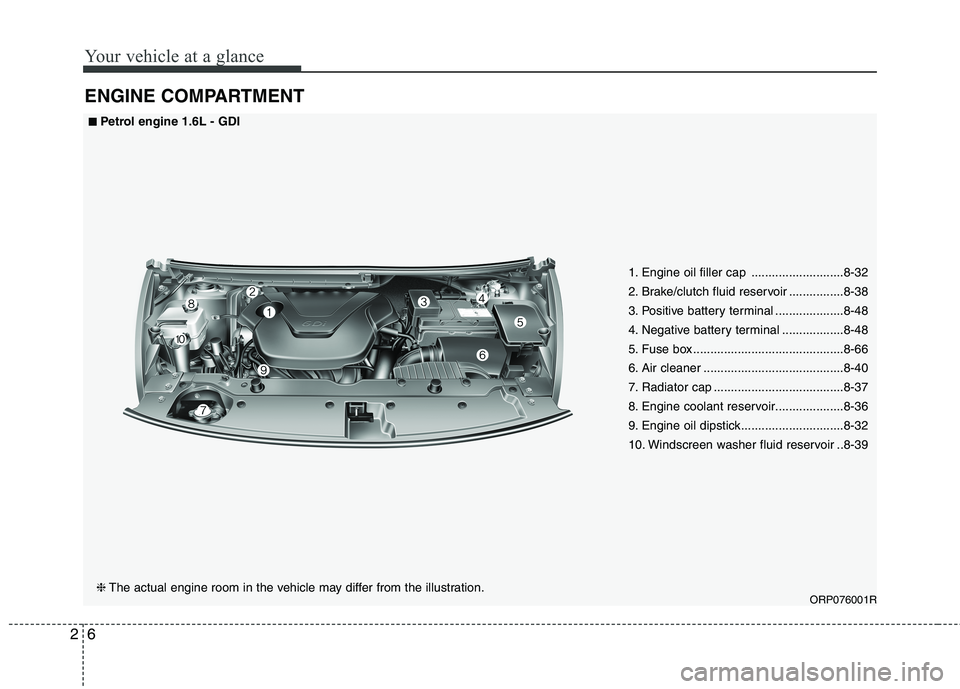
Your vehicle at a glance
6
2
ENGINE COMPARTMENT
ORP076001R
■■
Petrol engine 1.6L - GDI
❈ The actual engine room in the vehicle may differ from the illustration. 1. Engine oil filler cap ...........................8-32
2. Brake/clutch fluid reservoir ................8-38
3. Positive battery terminal ....................8-48
4. Negative battery terminal ..................8-48
5. Fuse box ............................................8-66
6. Air cleaner .........................................8-40
7. Radiator cap ......................................8-37
8. Engine coolant reservoir....................8-36
9. Engine oil dipstick..............................8-32
10. Windscreen washer fluid reservoir ..8-39
Page 17 of 723
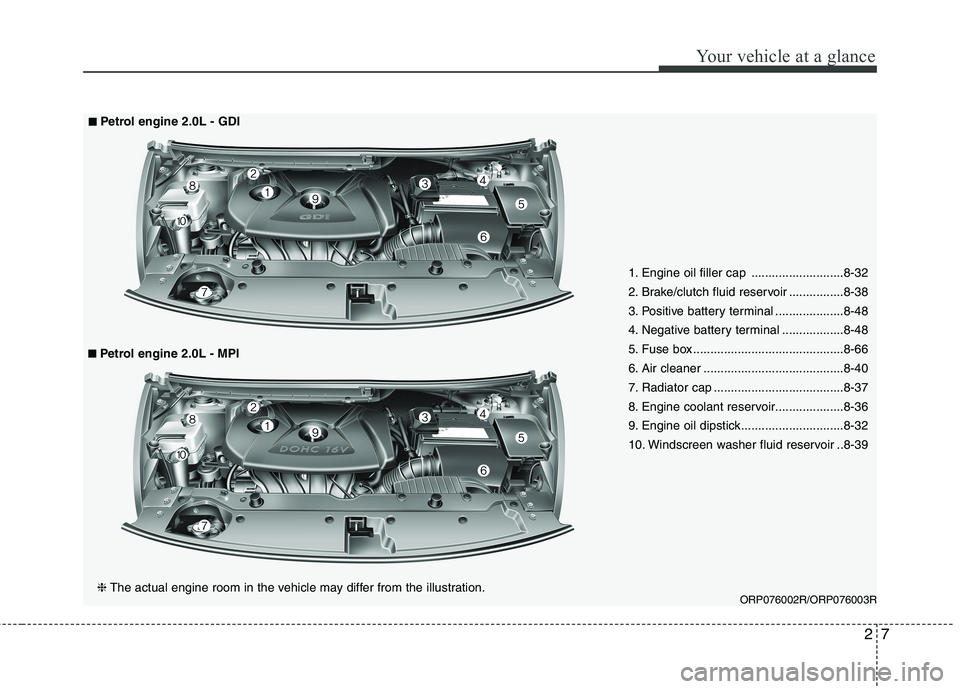
27
Your vehicle at a glance
1. Engine oil filler cap ...........................8-32
2. Brake/clutch fluid reservoir ................8-38
3. Positive battery terminal ....................8-48
4. Negative battery terminal ..................8-48
5. Fuse box ............................................8-66
6. Air cleaner .........................................8-40
7. Radiator cap ......................................8-37
8. Engine coolant reservoir....................8-36
9. Engine oil dipstick..............................8-32
10. Windscreen washer fluid reservoir ..8-39ORP076002R/ORP076003R
■■Petrol engine 2.0L - MPI
❈ The actual engine room in the vehicle may differ from the illustration.
■■
Petrol engine 2.0L - GDI
Page 18 of 723
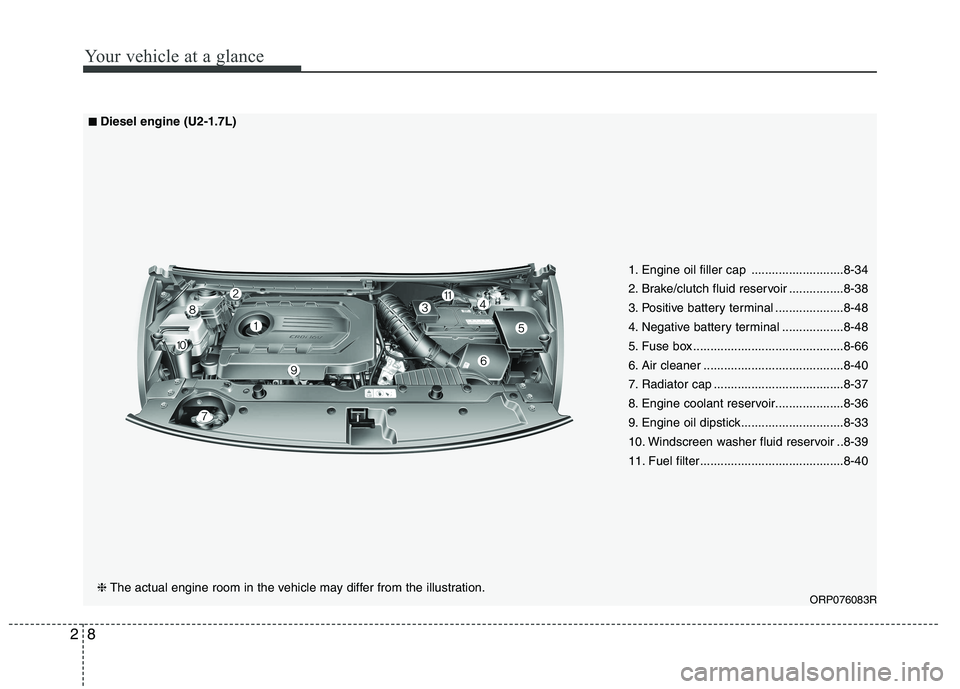
Your vehicle at a glance
8
2
1. Engine oil filler cap ...........................8-34
2. Brake/clutch fluid reservoir ................8-38
3. Positive battery terminal ....................8-48
4. Negative battery terminal ..................8-48
5. Fuse box ............................................8-66
6. Air cleaner .........................................8-40
7. Radiator cap ......................................8-37
8. Engine coolant reservoir....................8-36
9. Engine oil dipstick..............................8-33
10. Windscreen washer fluid reservoir ..8-39
11. Fuel filter..........................................8-40
ORP076083R
❈
The actual engine room in the vehicle may differ from the illustration.
■■
Diesel engine (U2-1.7L)
Page 157 of 723
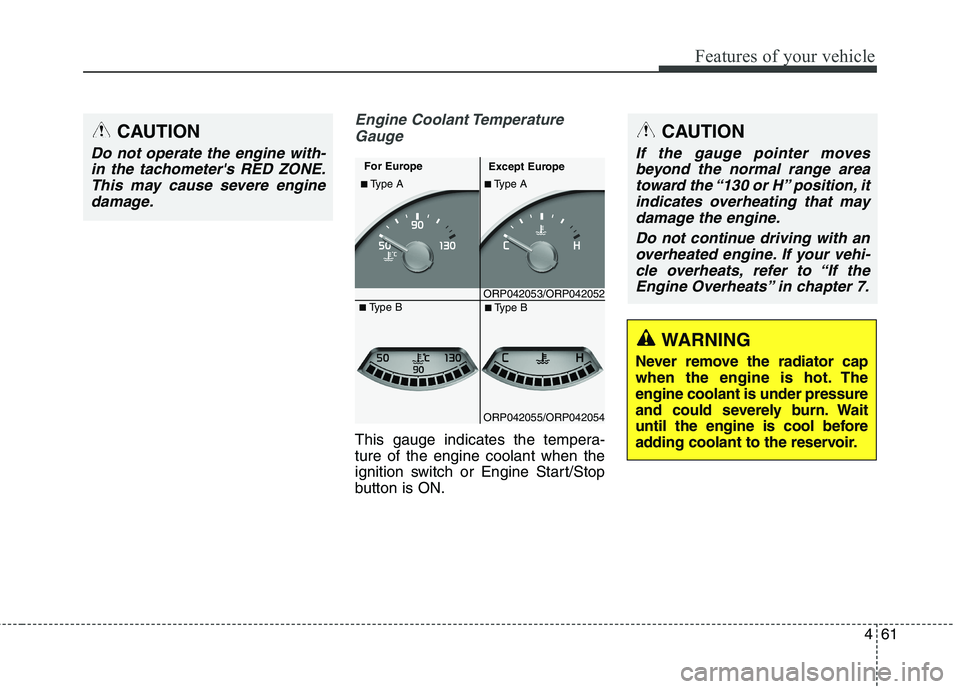
461
Features of your vehicle
Engine Coolant TemperatureGauge
This gauge indicates the tempera- ture of the engine coolant when the
ignition switch or Engine Start/Stop
button is ON.
CAUTION
Do not operate the engine with-in the tachometer's RED ZONE.This may cause severe engine damage.
ORP042053/ORP042052
■
Type A
For Europe
Except Europe
■ Type A
ORP042055/ORP042054■
Type B
■ Type B
WARNING
Never remove the radiator cap
when the engine is hot. Theengine coolant is under pressure
and could severely burn. Wait
until the engine is cool before
adding coolant to the reservoir.
CAUTION
If the gauge pointer moves beyond the normal range areatoward the “130 or H” position, itindicates overheating that may damage the engine.
Do not continue driving with anoverheated engine. If your vehi-cle overheats, refer to “If theEngine Overheats” in chapter 7.
Page 558 of 723
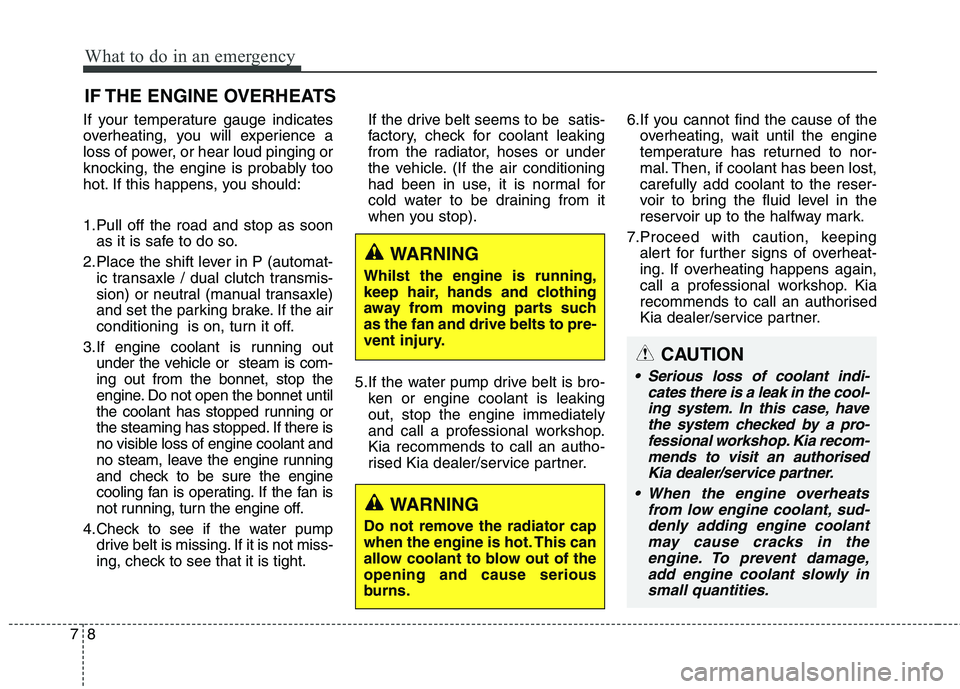
What to do in an emergency
8
7
IF THE ENGINE OVERHEATS
If your temperature gauge indicates
overheating, you will experience a
loss of power, or hear loud pinging or
knocking, the engine is probably too
hot. If this happens, you should:
1.Pull off the road and stop as soon as it is safe to do so.
2.Place the shift lever in P (automat- ic transaxle / dual clutch transmis-
sion) or neutral (manual transaxle)
and set the parking brake. If the air
conditioning is on, turn it off.
3.If engine coolant is running out under the vehicle or steam is com-ing out from the bonnet, stop the
engine. Do not open the bonnet until
the coolant has stopped running or
the steaming has stopped. If there is
no visible loss of engine coolant and
no steam, leave the engine running
and check to be sure the engine
cooling fan is operating. If the fan is
not running, turn the engine off.
4.Check to see if the water pump drive belt is missing. If it is not miss-
ing, check to see that it is tight. If the drive belt seems to be satis-
factory, check for coolant leaking
from the radiator, hoses or under
the vehicle. (If the air conditioning
had been in use, it is normal for
cold water to be draining from it
when you stop).
5.If the water pump drive belt is bro- ken or engine coolant is leakingout, stop the engine immediately
and call a professional workshop.Kia recommends to call an autho-
rised Kia dealer/service partner. 6.If you cannot find the cause of the
overheating, wait until the engine
temperature has returned to nor-
mal. Then, if coolant has been lost,carefully add coolant to the reser-
voir to bring the fluid level in the
reservoir up to the halfway mark.
7.Proceed with caution, keeping alert for further signs of overheat-
ing. If overheating happens again,
call a professional workshop. Kia
recommends to call an authorised
Kia dealer/service partner.
CAUTION
Serious loss of coolant indi-
cates there is a leak in the cool-ing system. In this case, have the system checked by a pro-fessional workshop. Kia recom-mends to visit an authorised Kia dealer/service partner.
When the engine overheats from low engine coolant, sud-denly adding engine coolantmay cause cracks in the engine. To prevent damage,add engine coolant slowly insmall quantities.
WARNING
Whilst the engine is running,
keep hair, hands and clothing
away from moving parts suchas the fan and drive belts to pre-
vent injury.
WARNING
Do not remove the radiator cap
when the engine is hot. This can
allow coolant to blow out of theopening and cause serious
burns.
Page 590 of 723
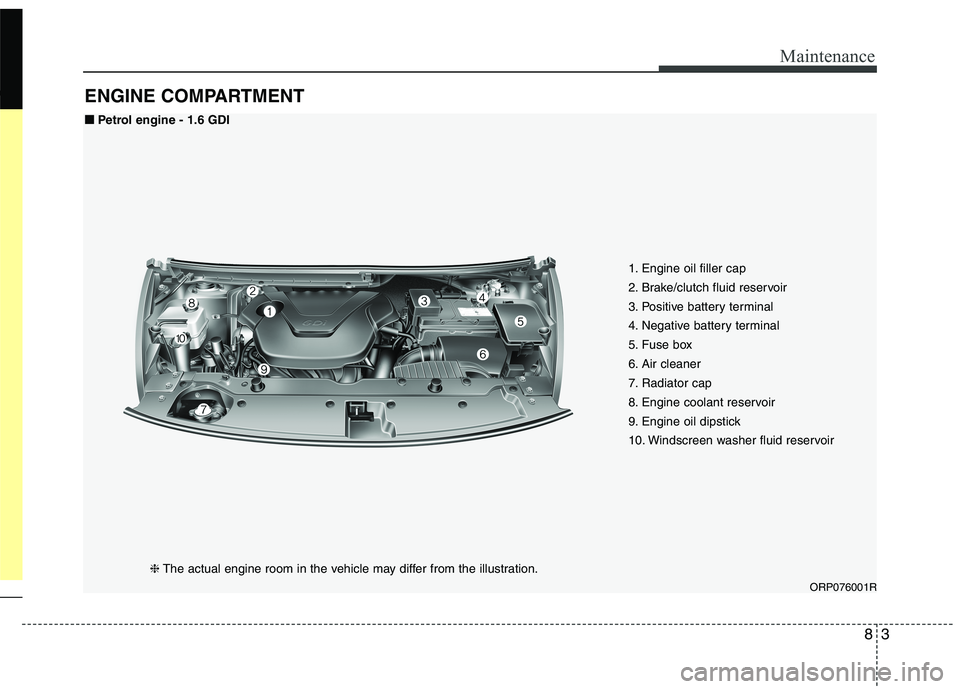
83
Maintenance
ENGINE COMPARTMENT
ORP076001R
❈
The actual engine room in the vehicle may differ from the illustration. 1. Engine oil filler cap
2. Brake/clutch fluid reservoir
3. Positive battery terminal
4. Negative battery terminal
5. Fuse box
6. Air cleaner
7. Radiator cap
8. Engine coolant reservoir
9. Engine oil dipstick
10. Windscreen washer fluid reservoir
■■
Petrol engine - 1.6 GDI
Page 591 of 723
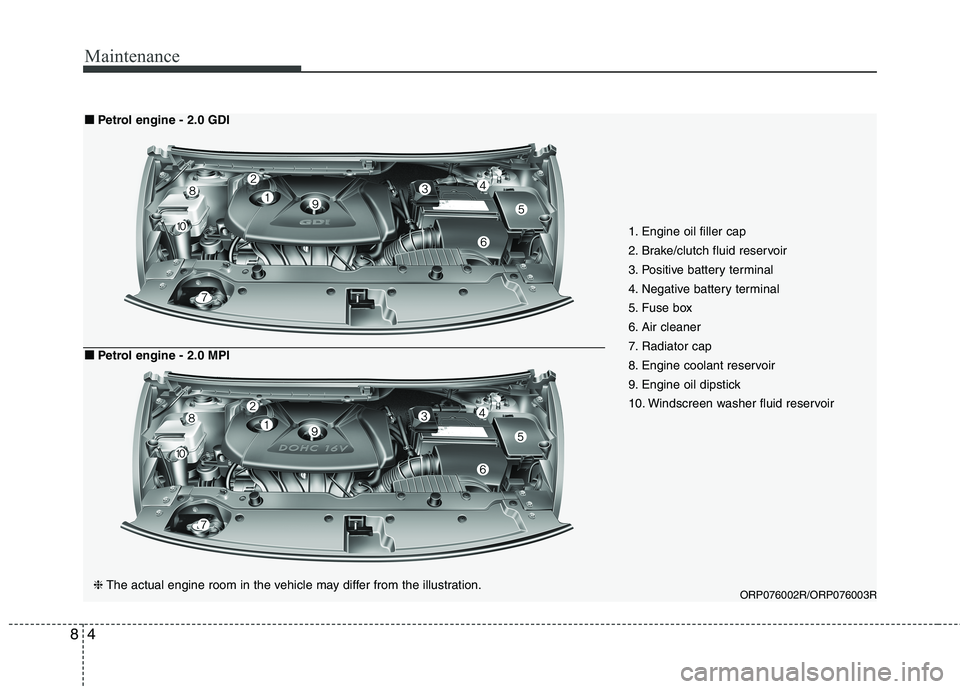
Maintenance
4
8
ORP076002R/ORP076003R
1. Engine oil filler cap
2. Brake/clutch fluid reservoir
3. Positive battery terminal
4. Negative battery terminal
5. Fuse box
6. Air cleaner
7. Radiator cap
8. Engine coolant reservoir
9. Engine oil dipstick
10. Windscreen washer fluid reservoir
■■
Petrol engine - 2.0 GDI
■■Petrol engine - 2.0 MPI
❈ The actual engine room in the vehicle may differ from the illustration.
Page 592 of 723
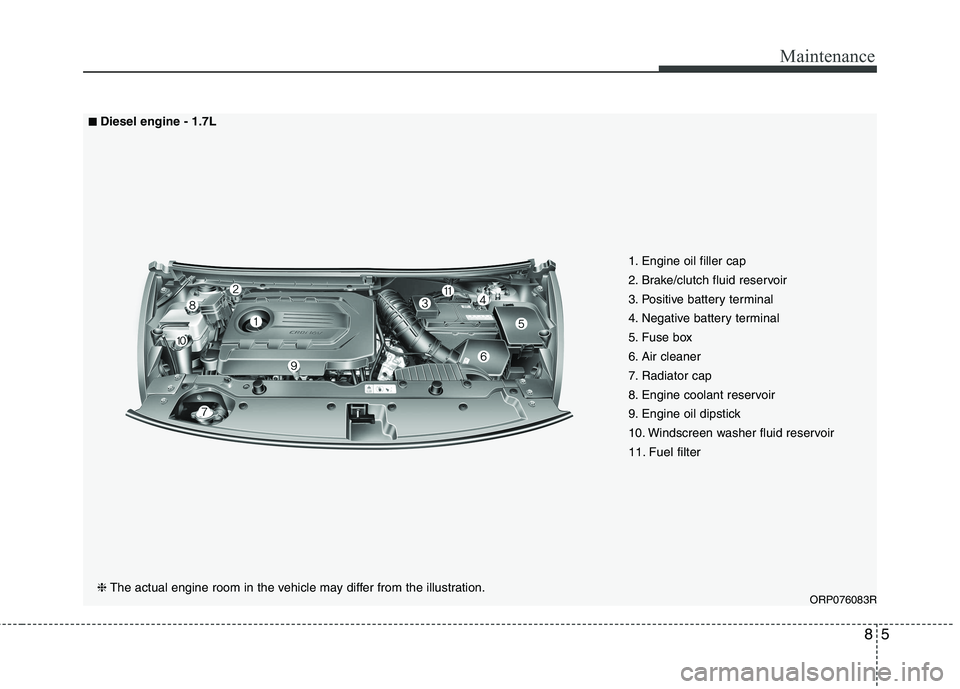
85
Maintenance
1. Engine oil filler cap
2. Brake/clutch fluid reservoir
3. Positive battery terminal
4. Negative battery terminal
5. Fuse box
6. Air cleaner
7. Radiator cap
8. Engine coolant reservoir
9. Engine oil dipstick
10. Windscreen washer fluid reservoir
11. Fuel filter
ORP076083R
❈
The actual engine room in the vehicle may differ from the illustration.
■■
Diesel engine - 1.7L
Page 596 of 723
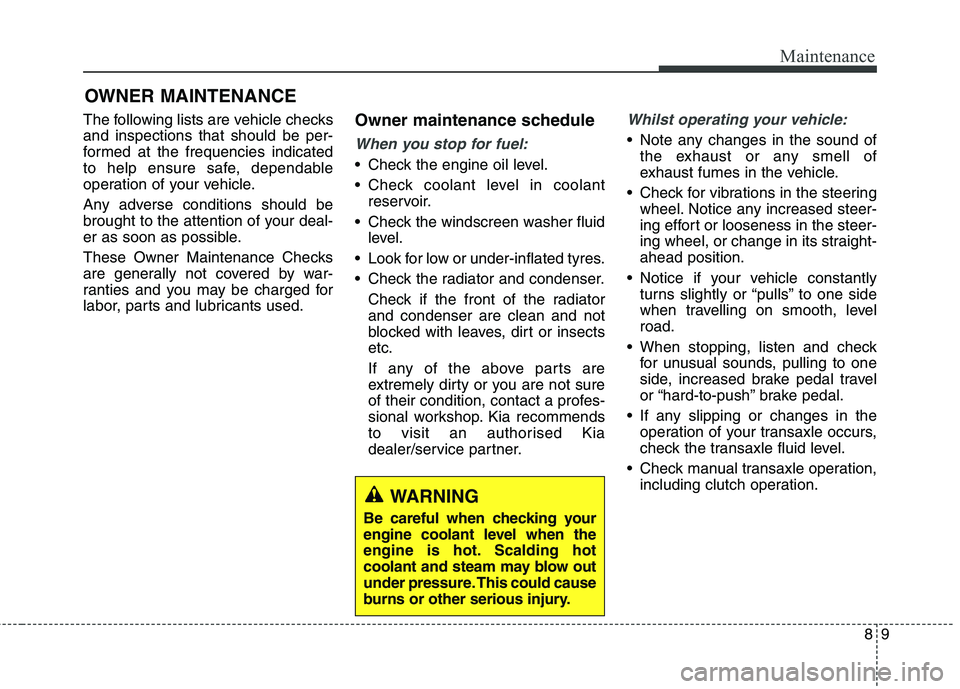
89
Maintenance
OWNER MAINTENANCE
The following lists are vehicle checks and inspections that should be per-
formed at the frequencies indicated
to help ensure safe, dependable
operation of your vehicle.
Any adverse conditions should be
brought to the attention of your deal-
er as soon as possible.
These Owner Maintenance Checks
are generally not covered by war-
ranties and you may be charged for
labor, parts and lubricants used. Owner maintenance schedule
When you stop for fuel:
Check the engine oil level.
Check coolant level in coolant
reservoir.
Check the windscreen washer fluid level.
Look for low or under-inflated tyres.
Check the radiator and condenser. Check if the front of the radiator and condenser are clean and not
blocked with leaves, dirt or insectsetc.
If any of the above parts are
extremely dirty or you are not sure
of their condition, contact a profes-
sional workshop. Kia recommends
to visit an authorised Kia
dealer/service partner.
Whilst operating your vehicle:
Note any changes in the sound ofthe exhaust or any smell of
exhaust fumes in the vehicle.
Check for vibrations in the steering wheel. Notice any increased steer-
ing effort or looseness in the steer-
ing wheel, or change in its straight-ahead position.
Notice if your vehicle constantly turns slightly or “pulls” to one side
when travelling on smooth, levelroad.
When stopping, listen and check for unusual sounds, pulling to one
side, increased brake pedal travel
or “hard-to-push” brake pedal.
If any slipping or changes in the operation of your transaxle occurs,
check the transaxle fluid level.
Check manual transaxle operation, including clutch operation.
WARNING
Be careful when checking your
engine coolant level when the
engine is hot. Scalding hot
coolant and steam may blow out
under pressure. This could cause
burns or other serious injury.
Page 597 of 723
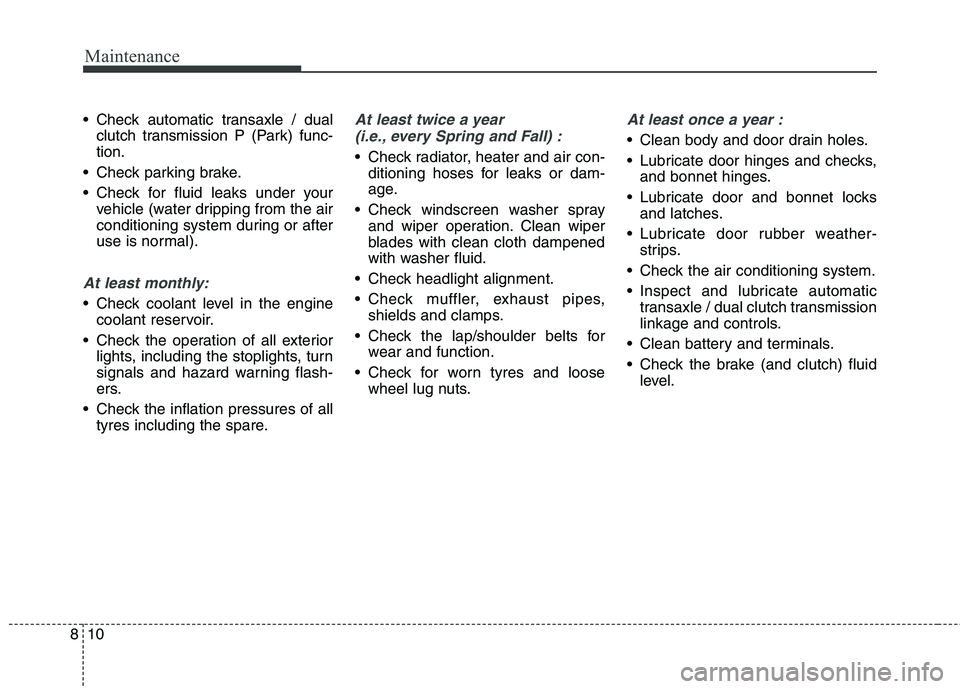
Maintenance
10
8
Check automatic transaxle / dual
clutch transmission P (Park) func- tion.
Check parking brake.
Check for fluid leaks under your vehicle (water dripping from the air
conditioning system during or after
use is normal).
At least monthly:
Check coolant level in the enginecoolant reservoir.
Check the operation of all exterior lights, including the stoplights, turn
signals and hazard warning flash-
ers.
Check the inflation pressures of all tyres including the spare.
At least twice a year
(i.e., every Spring and Fall) :
Check radiator, heater and air con- ditioning hoses for leaks or dam-
age.
Check windscreen washer spray and wiper operation. Clean wiper
blades with clean cloth dampened
with washer fluid.
Check headlight alignment.
Check muffler, exhaust pipes, shields and clamps.
Check the lap/shoulder belts for wear and function.
Check for worn tyres and loose wheel lug nuts.
At least once a year :
Clean body and door drain holes.
Lubricate door hinges and checks,and bonnet hinges.
Lubricate door and bonnet locks and latches.
Lubricate door rubber weather- strips.
Check the air conditioning system.
Inspect and lubricate automatic transaxle / dual clutch transmission
linkage and controls.
Clean battery and terminals.
Check the brake (and clutch) fluid level.